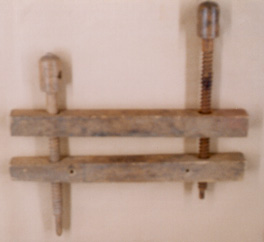 This clamp is very similar to a bookbinder's clamp, except
that
This clamp is very similar to a bookbinder's clamp, except
that1) the jaws are much less strong
2) the spindles are not so close to the ends.
Top Page > Clamps as Products > Users of Wooden Clamps (WC) > Sam Wing
Table of Contents
Note that Samuel Wing used to grouped with makers. He is now classifed as a user. This decision is subject to review.
There are two examples of Wing's clamps in storage at Old Sturbridge Village. The first to be described is similar to a bookbinder's clamp; the second is close to a hand screw. They can be dated to the end of the 1700s or the start of the 1800s.
There are also pieces of several dis-assembled clamps, in storage, with no obvious clues for re-assembly. It is not apparent that any pieces ever were assembled together; they may well be left over fragments of clamps whose broken parts were discarded.
I know of no earlier clamps in America. These provide a gllimpse into the origins of hand screws.
 This clamp is very similar to a bookbinder's clamp, except
that
This clamp is very similar to a bookbinder's clamp, except
that
1) the jaws are much less strong
2) the spindles are not so close to the ends.
There are no marks on any jaws. Wing apparently made this for his personal use, and saw no need to identify himself as the maker.
The jaws are characteristically squared off, with no slope.
One jaw has two holes, with recesses. I can speculate that this jaw was fitted to pegs in, or screwed to, the workbench, then the other jaw was tightened about the work piece, either for carving, for inlay, or some other purpose.
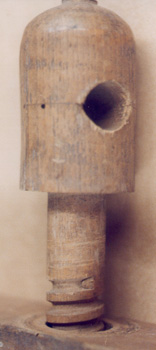 The
spindles are nearly identical, with large bulky handles. There is
a large hole bored through each handle, presumably to afford
greater leverage in using the clamp.
The
spindles are nearly identical, with large bulky handles. There is
a large hole bored through each handle, presumably to afford
greater leverage in using the clamp.
The threads on each spindle are approximately square at the root and at the top, not the usual V-shape. The picture shows however that it was made with a cutter, not by a chisel.
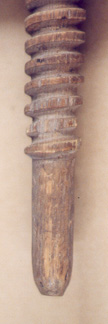 One however has a long tapering tip. The need
for this is not apparent.
One however has a long tapering tip. The need
for this is not apparent.
 The other has a short stub. The purpose of the
hole in the stub is not obvious.
The other has a short stub. The purpose of the
hole in the stub is not obvious.
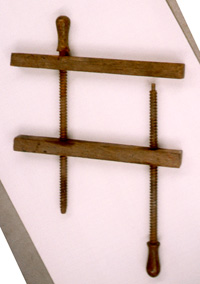 This is much closer to the usual hand screw, except that the
middle spindle is far off-center.
This is much closer to the usual hand screw, except that the
middle spindle is far off-center.
The jaws are characteristically squared off, with no slope.
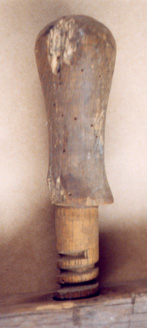 The spindles are nearly identical, with large
bulbous handles.
The spindles are nearly identical, with large
bulbous handles.
The threads on these spindles are approximately square at the root and at the top, not the usual V-shape. The picture shows however that it was made with a cutter, not by a chisel.
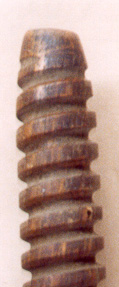 This through spindle has a short conical stub.
This through spindle has a short conical stub.
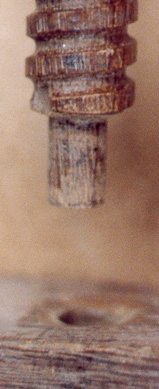 This stopped spindle has a short stub, like the usual stopped
spindle.
This stopped spindle has a short stub, like the usual stopped
spindle.
I'd like to thank the curator and staff at Old Sturbridge Village for provided access to these items in storage, and for sharing ideas about the development of the hand screw.
The Old Sturbridge Village (OSV) has the contents of Samuel Wing's workshop. Included among the treasures are two assembled clamps, and parts of dis-assembled clamps. Number 1 shows the first, and Number 2 shows the second clamp. I would like to share with you the results of my examination and analysis of them.
First, the clamps as currently assembled do belong together. The holes in the jaws line up with each other; the handles on the spindles match the wear on the jaws. They may have been used in other configurations as well, but the parts do go together.
Samuel Wing Photos taken by author at OSV
last revised and validated
Copyright © 1996- Wooden Clamp Journal